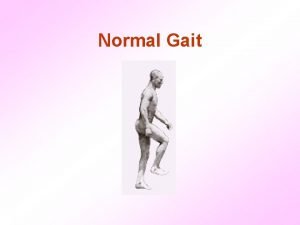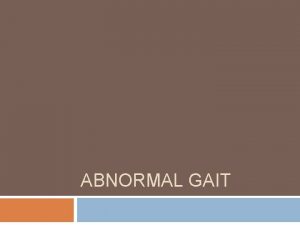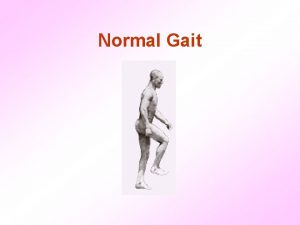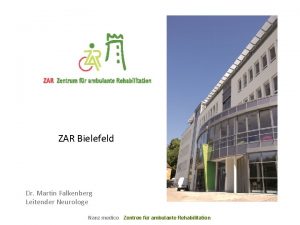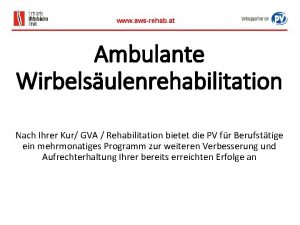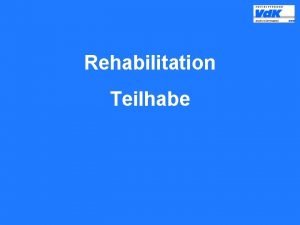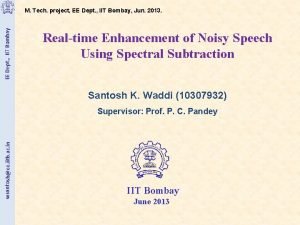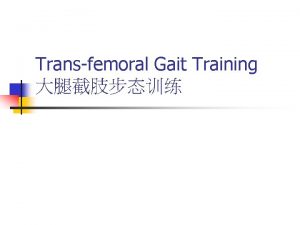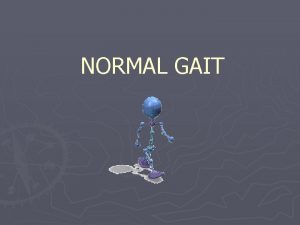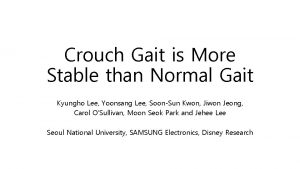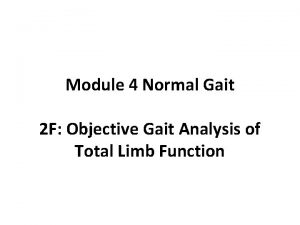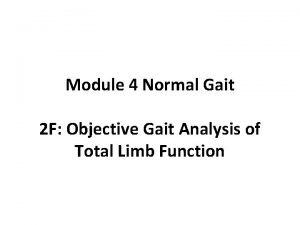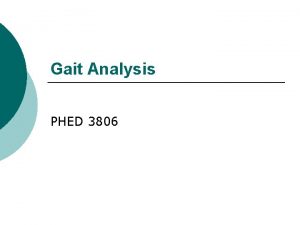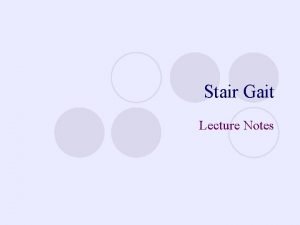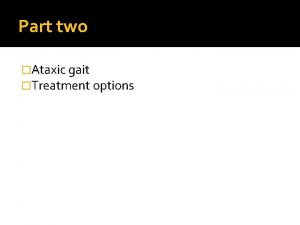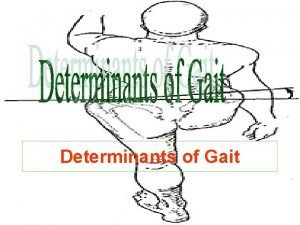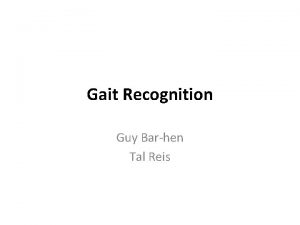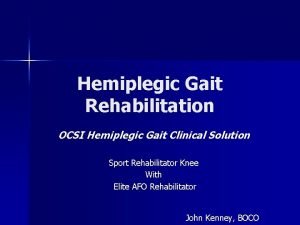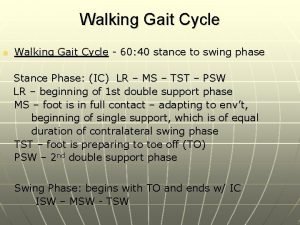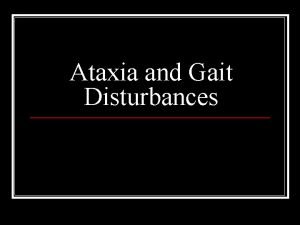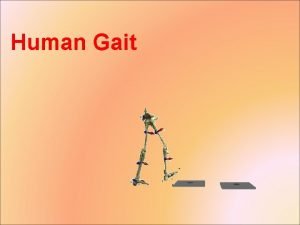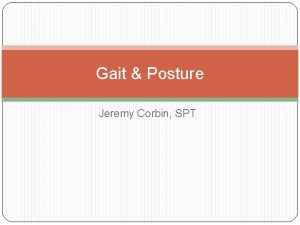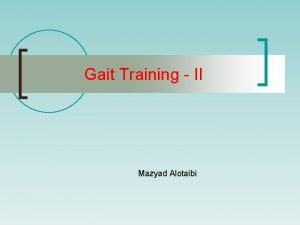Analysis of normal gait Namyangju Reha Hospital Dept












































- Slides: 44

Analysis of normal gait Namyangju Reha. Hospital Dept. of Physical Therapy Lee Dong-Jin, PT

Gait Cycle �Walking uses a repetitious sequence of limb motion move the body forward while simultaneously maintaining stance stability.

Cycle Divisions

Floor Contact Periods �Stance Initial Double Stance Single Limb Support Terminal Double Stance �Swing 60% 10% 40%

Stride & Step

Stride & Step

Divisions of the Gait Cycle

1단계 : Initial Contact (heel strike) • 보행주기 중 0~2%에 해당 - 체중부하 패턴을 결정 - Heel Rocker가 작용한다. • 주요사건 : Heel Strike • 작용근육 : Gluteus maximus, hamstring, tibialis anterior, qudriceps(eccentric) • Hip : 30도 Flex -Vector : 전방 • knee : Ext(2도 Flex) - Vector : 전방 • Ankle : neutral - Vextor : 후방

2단계 : Loading Response (foot flat) • 보행주기 중 0 ~ 10%에 해당 - Initial Double Limb Stance. - 반대측이 IS 될 때까지 지속. - 충격흡수, 체중부하 안정성, 전진기능 • 주요사건 : Knee, Ankle Flex 제한, Hip jt 안정화 • 작용근육 : gluteus maximus, quadriceps, biceps femoris, tensor fascia latae • Hip : 30° Flex, Add, I/R - Vector : 전방 • Knee : 18°Flex, Valgus, Tibia I/R - Vector : 후방 • Ankle : 10°plantarflexion, Pronation - Vector : 후방 - 충격흡수, Tibia Advance


4단계 : Terminal stance (heel off) • 보행주기 - 반대측 - 체중이 체간을 중 30~50%에 해당 : IC직전까지 발의 전반부 이동하는 단계이며, 앞으로 이동시킨다. • 주요사건 : Heel Push off • 작용근육 : soleus, gastrocnemius(eccentric) T. F. L(Hip Flex, Abd역할) • Hip : hyper Ext, Add, I/R - Vector : 후방 • Knee : 0~5°Flex, Tibia E/R - Vector : 전방 • Ankle : 10°D/F, Supination - vector : 전방


6단계 : Initial Swing (acceleration) • 보행주기 중 60~73%에 해당 - Toe off에서 시작. - 하지를 전방으로 이동하는 단계. • 중요사건 : Knee, Hip Flex • 작용근육 : biceps femoris, sartorius, gracillis, tibialis anterior, iliacus • Hip : gracillis에 의해 20°Flex • Knee : biceps femoris 에 의해 60°까지 Flex • Ankle : 20°P/F에서 tibialis anterior의 작 으로 인해 Neutral 상태로.


8단계 : Terminal Swing (deceleration) • 보행주기 중 85~100%에 해당 - Tibia 직각에서 발이 닿을 때까지. - 하지를 전방으로 이동하는 단계 • 주요사건 : Hip, Knee의 감속, Knee Ext, Ankle D/F • 작용근육 : Hamstring, Quadriceps, Pretialis m. • Hip : Hastring 작용으로 인해 Flex 제한 • Knee : Hastring 작용으로 인해 MSw시에 Ext되는 Knee jt를 제한, Quadriceps작용하여 Knee Ext유지 • Ankle : Tibialis anterior의 작용으로 netutal 이나 5°P/F

Head, Trunk, Pelvic 운동양상 <Head and Trunk> <Pelvic> 1. 수직 변위 - 2. 5 ~ 4. 5 cm - 최대하방 변위 : LR , PSw (DS 단계) - 최대상방 변위 : TSt, MSw (SS 단계) • 지지하는 Hip jt에서 운동 발생 2. 측 변위 - 평균 4. 5 cm - stance 쪽으로 일어난다. 2. Coronal plane - anterior tilt 4° 3. Transverse plane - rotation 10° 3. 전방 변위 - 천골 : 23 cm/sec - 흉부 : 14 cm/sec - 두부 : 2 cm/sec 1. Sagjital plane - pelvic drop 4°

vertical displacement of trunk during a stride indicated by head height

Lateral displacement of trunk during a stride

Motion of the pelvis during walking



Arm swing during normal free walk

입각기의 근육 조절 형태 1. Terminal Swing(Initial Contact, heel strike) 1. Hamstring - Hamstring은 MSt말기에서 활성화 되어 TSw 초기에 활동 - Hip Flex 억제 - Knee Hyper-Ext을 방지한다. - TSw 후반부터는 Hamstring의 작용이 감소한다. 2. Hip Extensor ( Adductor Magnus, Gluteus Maximus) - Hamstring의 작용이 감소하면서 이들 근육이 활성화된다. - Quadriceps 가 Knee Ext을 유지하기 위해 Hamstring과 반대로 작용. - Tibialis anterior가 재활성화 되어 Ankle Dorsiflexion을 유지한다.

입각기의 근육 조절 형태 2. Loading Response(foot flat) 1. Hip joint - Hip Extensor( Adductor Magnus, Gluteus Maximus inferior)가 Femur에 붙어 Hip, Knee, Ext을 담당 - Hip Abductor ( Gluteus Matimus superior, Gluteus medius)는 Femur 안정성을 강화. 2. Knee Joint - Quadriceps가 Heel Rocker에 의해 시작되는 Knee jt 의 Flex을 제한하여 weight bearing에 안정성을 제공한다. 3. Ankle Joint - Tibialis anterior가 LR초기에 eccentric으로 최대활동하며, weight bearing동 안 충격흡수를 위하여 Knee Flex 초기에 heel rocker를 제공한다.


유각기의 근육 조절 형태 1. Pre Swing 1. Hip adductor ( Adductor longus) - Addutor longus 는 Hip abduction 제한하기위해 활성화되며, Hip Flex시킨다. 2. Rectus femoris - PS말기에 활성화되어 Knee hyper Flex을 제한하며, Hip jt 를 Flex시켜 하지가 전진 되는 것을 돕는다. 3. Tibialis anterior - PS ½후에 활동적이 되며 Plantarflexion을 제한한다.

유각기의 근육 조절 형태 2. Initial Swing 1. Sartorius, Iliacus, Gracilis - 이들 근육이 수축하여 Femur를 전방으로 전진시킨다. 2. Biceps femoris(short head) - Knee Flex시킨다. – foot lift를 위해. 3. Tibialis anterior - PS에서 시작하여 IS까지 지속하며, Pantarflexion상태의 발을 들어올리는 역할 은 한다.

Loading Response (foot flat) What is Loading Response



What is Loading response ? Gait cycle Stance Swing Weight Acceptance Initial Contact Loading Response Single Limb Support Mid Stance Terminal Stance Pre Swing

What is Loading response ? � LR 의 시작 시기 - TSw 마지막 부분(바닥 1 cm위)부터… � LR의 기능적인 목적 - 다른 다리로 체중이 옮겨 가는 것을 조절한다. � LR시기의 수행과제 - shock absorption - preservation of progression - weight-bearing stability

What Happens During Loading Response ? (leg) � Hip jt : 30°Flex - Transverse : E/R 에서 I/R 된다. - Coronal : slight adduction 된다. � Knee jt : 0 ~ 10°Flex - LR 시작시에는 Hyper. Extension 에서 10°Flexion된다. � Ankle jt : Neutral ~ 10°도 P/F ~ Neutral � Subtalar jt : Eversion (Pronation) � Talar jt : Extension

What Happens During Loading Response ? (arm&trunk) � Contralateral leg : Pre Swing � Ipsilateral leg : Ext 에서 Felx 으로 swing � Contralateral arm : Ext쪽으로 움직인다. � Trunk : Elect

What Happens During Loading Response ? (Vector&Torque) � Hip jt : Torque into Flexion, Adduction, I/R � Knee jt : Torque into Flexion � Ankle jt : Torque into P/F → Torque into D/F

Loading Response 의 Neutral Vector line � Force Vector : Hip (앞), Knee , Ankle(뒤 ) Posterior Elevation � LR 시의 Vector line은 cranial-dorsal에서 caudal-ventral 쪽을 지나는 대각선에 위치 한다. Anterior Depression � 이때의 선은 Pelvic이나 Scapular의 Post. Elev , Ant. depr groove 방향과 거의 평행 하다. � 따라서 이 두개 패턴의 groove는 LR와 관련 된 근육을 촉진하는데 매우 유용한 패턴이 다.

Proposal for Facilitation of Loading Response (1) � 촉진을 위한 하지 관절의 위치 - 동측 ~ Hip : 30°Flex, Knee : 15°Flex, Ankle : Neutral - 반대측 ~ Leg : Ext , Trunk & Head : Neutral � Approximation for Knee & Ankle - Heel이 닿아 있는 Kinematic chain 에서 실시한다. - 이는 동작에 필요한 적당한 근육 작용을 촉진할 수 있다.



Standing에서 LR 촉진하기 � Contact 과 촉진 1. Right hand - starting : Iliac crest Approximation 적용 위해 - end : Greater trochanter fossa Hip Ext. Rotator 촉진 위해 2. Left hand - starting : Tibia Inner part tibia를 앞쪽으로 당긴다. - end : Tibia Int. Rotator를 촉진한다.

Sidelying에서 LR 촉진하기 � Contact과 촉진 1. Starting - 치료사는 Vector 방향으로 Approximation - 환자는 forefoot를 떼고 있다. 2. End - 환자는 forefoot을 벽에 댄다. - 치료사는 Pelvic을 Ant. depr시킨다. � Quadriceps, Ext. Rotator, Abductor를 촉 진하기 위해 한 손을 Thigh로 옮길 수 있 다.

Normal Gait

Reference � Jacquelin Perry. GAIT ANALYSIS Normal and Pathological Function, 1992 � Adler SS, Beckers D, Buck M. PNF in practice. 2 nded , Springer, 2000 � David J. Magee. Orthopedic Physical Assessment. 3 rded. W. B. Saunders. 1998

Thank You!
 Loading response gait
Loading response gait Waddling gait
Waddling gait Medical term for normal gait
Medical term for normal gait Nervenarzt bielefeld
Nervenarzt bielefeld Krankenhaus lauchhammer geriatrie
Krankenhaus lauchhammer geriatrie Reha groten würselen
Reha groten würselen Www.aws-rehab.at
Www.aws-rehab.at Anu reha
Anu reha Reha cengizlier
Reha cengizlier Reha tözün
Reha tözün Schulische reha
Schulische reha Hospital pharmacy functions
Hospital pharmacy functions Dept nmr spectroscopy
Dept nmr spectroscopy Fl dept of agriculture
Fl dept of agriculture Finance department organizational chart
Finance department organizational chart City of worcester inspectional services
City of worcester inspectional services Dept. name of organization (of affiliation)
Dept. name of organization (of affiliation) Mn dept of education
Mn dept of education Department of finance and administration
Department of finance and administration Dept. name of organization (of affiliation)
Dept. name of organization (of affiliation) Employment first ohio
Employment first ohio Poster affiliation
Poster affiliation Vaginal dept
Vaginal dept Gome dept
Gome dept Gome dept
Gome dept Nyttofunktion
Nyttofunktion Gome dept
Gome dept Hoe dept
Hoe dept Fire dept interview questions
Fire dept interview questions Oviposition
Oviposition Dept of education
Dept of education Florida dept of agriculture and consumer services
Florida dept of agriculture and consumer services Florida dept of agriculture and consumer services
Florida dept of agriculture and consumer services Dept a
Dept a Central islip fire dept
Central islip fire dept Rowan county dss child protective services
Rowan county dss child protective services Dept of education
Dept of education Tabella nmr
Tabella nmr Pt dept logistik
Pt dept logistik Nys dept of homeland security
Nys dept of homeland security Affiliate disclodures
Affiliate disclodures La revenue dept
La revenue dept Oxford dept of continuing education
Oxford dept of continuing education Nebraska dept of agriculture
Nebraska dept of agriculture Ee dept iitb
Ee dept iitb
